|
|
|
Professor Peter Griffiths has been
selected as editor-in-chief of Applied Spectroscopy
(more...)
Professor Griffiths is (Officially)
Retired
A Symposium in Honor of Professor Peter R. Griffiths
Dr. Griffiths at U.S.
Pharmacopeia
Professor Peter Griffiths has been elected to
membership on the General Chapters Expert Committee for U.S.
Pharmacopeia (USP) for the 2005-2010 cycle.
Dr. Peter Griffiths honored with a Humboldt Research Award for Senior United States Scientists
The award is granted to internationally
acknowledged scientists in recognition of their academic
achievements. It includes a grant to support a research at one of the
universities in Germany of the awardee's choice for a period between six months to one year.
Professor Griffiths will take sabbatical from August 2006 till May 2007
to leave for Technical University of Dresden where he will work with
prof. Reiner Salzer. The project will include involvement of vibrational
spectroscopy to detect diseased areas in the body using a fiber optic
probe.
Lacey Averett
Wins!!!
Lacey Averett won the election for the
student
representative position of the Society of Applied Spectroscopy.
Lacey will take the position from Debbie Serna (New
Mexico State University) who served as a wonderful representative. People
close to the Lacey Averett campaign say that Lacey hopes to be able to
serve in the capacity of student representative as honorably as Debbie.
Congratulations from the FT-Guys to Lacey and to the SAS!

PETER GRIFFITHS IS
RECIPIENT OF THE BOMEM-MICHELSON AWARD
Peter Griffiths, Professor and Chair of the Department of
Chemistry at the University of Idaho, will receive the
2003 Bomem-Michelson Award by the Coblentz Society. The Award,
dedicated to the memory of Professor A.E.Michelson, and
sponsored by Bomem,Hartmann &Braun, is presented
annually to honor scientists who have advanced the techniques
of vibrational, molecular, Raman, or electronic
spectroscopy. Griffiths’ research interests have been in the
development of better ways of measuring infrared
spectra, including the optics for diffuse reflection
spectroscopy and the chromatography/FTIR interface. Much of
the effort in his lab over the past four or five years has
involved development of the hardware and software for open-path
FTIR spectrometry and investigations into surface-enhanced
infrared absorption (SEIRA) spectrometry for reducing the
detection limits of direct-deposition interfaces between gas and
liquid chromatographs and the identification of intermediates in
electrochemical reactions. More recently, Griffiths’ students
have been working with a small business in Moscow, Idaho,
Manning Applied Technology, to construct an ultra-rapid-scanning
interferometer that allows full infrared spectra to be measured in
as short a time as one millisecond. This instrument has been
used to monitor time-resolved adsorption, very fast combustion
and photochemical reactions, and polymer dynamics on the
millisecond timescale. Griffiths’ group maintains a strong interest
in various types of reflection spectroscopy.
Professor Griffiths obtained his B.A. and D.Phil. in Chemistry
from Oxford University in England. After a two-year post-doctoral
stint at the University of Maryland, he worked with Digilab,Inc.
(which became the Spectroscopy Division of Bio-Rad and is now
Digilab LLC) on the development of the first FTIR spectrometer
of the modern era. Subsequently he held positions with Sadtler
Research Labs, Ohio University, and the University of California,
Riverside, before being appointed as Chair of the Department of
Chemistry at the University of Idaho, a position he has held for
eight years. Griffiths has received several honors and awards
including the Coblentz Award in 1975, the Spectroscopy Society
of Pittsburgh Award, the Prëgl medal of the Austrian Society
of Analytical Chemistry, the Gold Medal Award of the New York
SAS and the University of Idaho Award for Research and
Creative Activity, all in 1995. He is also on the editorial
advisory boards of the following journals: Spectroscopy
Letters, Spectrochimica Acta, Analytical and Bioanalytical
Chemistry (Germany), Analytical Sciences (Japan) and
Spectroscopy and Spectrochemical Analysis (China).
Griffiths has co-authored over 240 papers, 25 book chapters and
two books. The second edition of Fourier Transform Infrared
Spectroscopy, which he wrote with James de Haseth, will
appear next Spring. He is a co-editor, with John Chalmers, of the
Handbook of Vibrational Spectroscopy, a major five-volume text
covering all aspects of mid-infrared, near-infrared and Raman
spectroscopy which was introduced December,2001.
FT-GUY PRESENTATIONS AT PITTCON 2003
APPLICATIONS OF
ULTRA-RAPID-SCANNING FTIR SPECTROMETRY TO TIME-RESOLVED ADSORPTION AND
POLYMER DYNAMICS
Peter R. Griffiths, Benjamin Weinstock, Husheng Yang
Interferometers in which one or more mirrors move in a reciprocating
manner often have a very low duty cycle efficiency. For example
with one commercial interferometer, it has been reported that the
measurement time for an interferogram corresponding to a
16-cm -1 resolution spectrum is 4 ms yet it takes 40 ms to decelerate the
moving mirror, turn it around and accelerate it back up to
the desired velocity. In this case, the duty cycle efficiency (i.e., the
time required to acquire the interferogram divided by the time
between scans) is less than 10%. By designing an interferometer with a
rotating, rather than reciprocating, optical element, instruments
with a much higher duty cycle efficiency can be designed. In this talk, an
instrument that allows 6-cm -1 resolution spectra to be
measured every 5 ms will be described. Even when the beam passes through a
20-pass gas cell, the rms noise level is about 1000 (<1 mAU
root mean square baseline noise when the ratio of two successive scans is
calculated). Prognostications of how the scan speed and/or
resolution can be further improved will be given. The application of this
instrument to two applications will be given. In the first of
these, an approach for measuring the kinetics of the adsorption of small
aldehydes onto bare and modified silica will be described.
In the second, the change in molecular conformation as polymer films are
stretched to the point at which they fracture will be shown.
Below is shown the variation of the absorbance of acetaldehyde as a
mixture of acetaldehyde and nitrogen is admitted to a multi-pass
gas cell through either unmodified silica or the same silica after
treating the surface with aminopropylsilyl (APS) groups. Also
shown (filled circles) is the variation of pressure in the cell during the
same period.
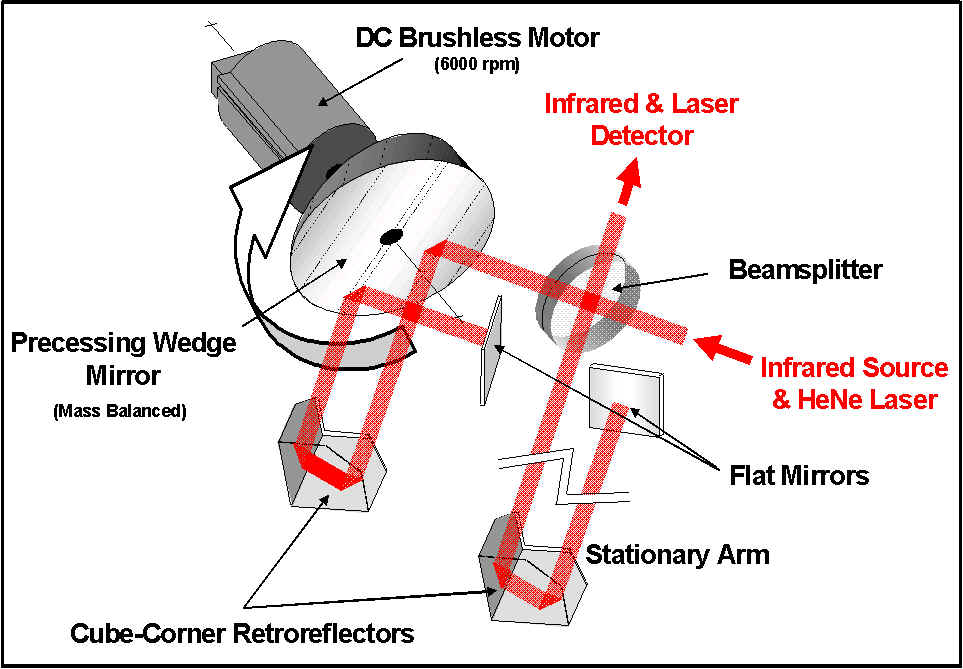
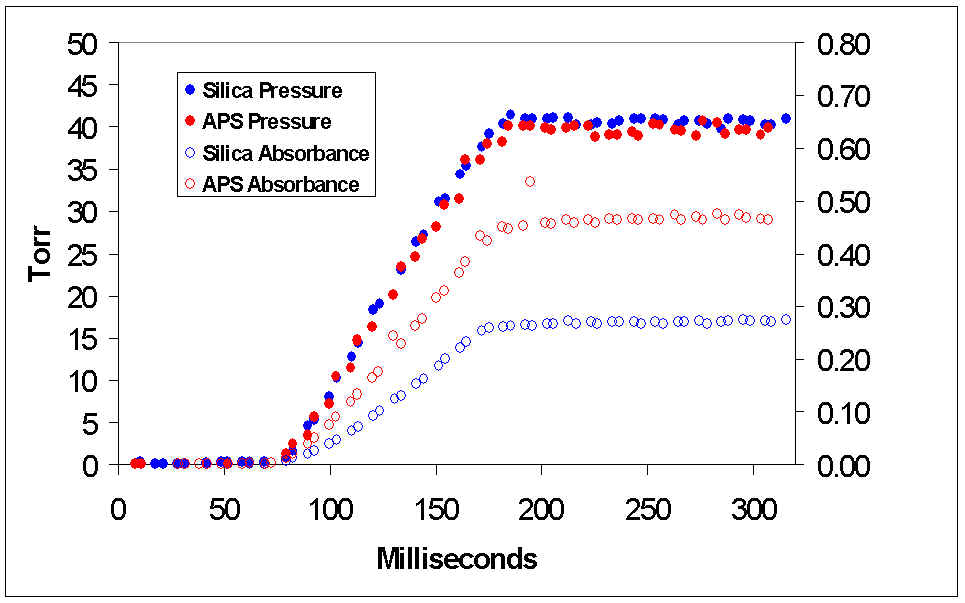
CLICK HERE FOR THE ACS C&E NEWS WRITEUP ON THIS SYMPOSIUM
SURFACE-ENHANCED INFRARED
ABSORPTION: HOW LARGE AND HOW USEFUL?
Peter R. Griffiths, Amy E. Bjerke,
David A. Heaps
Enhancement in the intensity of bands in the infrared spectrum of
materials within about 5 nm of the surface of small islands of silver
and gold has been reported to be anywhere between one and three orders of
magnitude, with enhancement factors of 100 to 200 being most
common. The biggest problem in the application of surface-enhanced
infrared absorption (SEIRA) that we have found is the
asymmetry of the bands. In the first part of this talk, the factors
affecting band asymmetry will be discussed. In the second
part, the application of SEIRA to the direct deposition interface of gas
and liquid chromatographs with FT-IR spectrometers will be
discussed. By coating the substrate on which the analytes are deposited
with a thin layer of silver, detection limits can be reduced
by about a factor of ten. GC/FT-IR spectra of 8.6 ppm of t-butyl benzene
deposited on a ZnSe slide held at liquid nitrogen temperature
are shown. The lower spectrum was measured on the bare ZnSe slide while
the upper spectrum was measured after depositing 5 nm of
silver on the surface on the slide. In the third part of this talk, the
feasibility of obtaining significant surface enhancements
with metals other than the coinage metals will be discussed. Our group has
observed significant enhancements using platinum and
palladium, while other groups have seen similar results with iron, tin and
rhodium. In most spectra measured on these substrates,
however, the bands are very asymmetrical. In the final part of this talk,
the feasibility of SEIRA being the basis of a generally
applicable technique for surface analysis will be discussed.
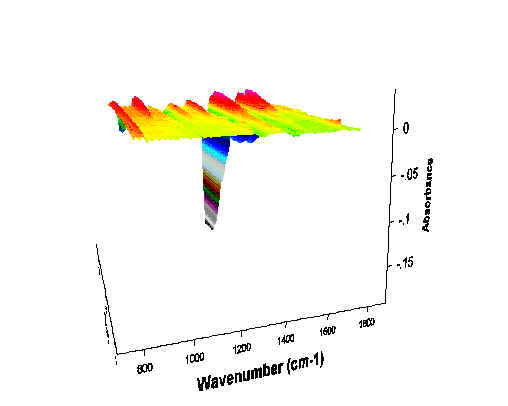
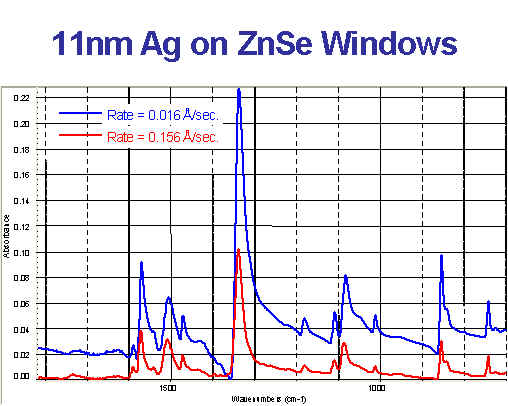
AUTOMATED
COMPOUND IDENTIFICATION AND QUANTIFICATION IN OPEN-PATH
FOURIER TRANSFORM INFRARED SPECTROMETRY
Husheng Yang, Peter R. Griffiths, B. Christine Morris
In
recent years more attention has been turned to open-path Fourier transform
infrared (OP/FT-IR) spectrometry for monitoring hazardous
gas-phase compounds in the work-place, chemical weapons storage
facilities, and other similar sites. The increased number of
applications demand faster and more reliable data analysis systems.
However, the currently accepted data processing method in
OP/FT-IR, classical least squares (CLS) regression, is far from being
automatic and robust. In this work we describe a systematic
approach for building a fully automated system by utilizing modern
computer programming techniques and advanced chemometric
algorithms, and demonstrate that such a system can automatically identify
and quantify 19 target compounds. In the first step of
building the automated data analysis system reference spectra of 114
target and interferent compounds and 843 open-path background
spectra were collected. In the second step, Kohonen neural network and
chemometrics tools were used to analyze the reference spectra
library so that efficient training and testing sets can be constructed. In
the third step, a neural net-work library that contains
several feed-forward neural networks, each of which can recognize one of
the target compounds or representative interferents, is
constructed. Each training spectrum was synthesized by the digital
addition of several reference spectra and an open-path
background spectrum. Figure 1 shows a synthetic methyl amyl acetate OP/FT-IR
spectrum in the presence of two interferents. Identifying
this compound presents a challenge even to an expert spectroscopist. The
data analysis system is fully automated. When the instrument
set-up is changed, a new model can be rebuilt by issuing a single computer
command. The final system is a software package that is
installed in a personal computer and fully integrated with the data
acquisition soft-ware that controls the OP/FT-IR
spectrometer. This system contains the neural network library, an
automated partial least squares (PLS) calibration model
generator, and auxiliary computer programs. This system gave near
real-time prediction of the identity and concentration of
target compounds once an OP/FT-IR spectrum is collected and fed to the
system instantly.
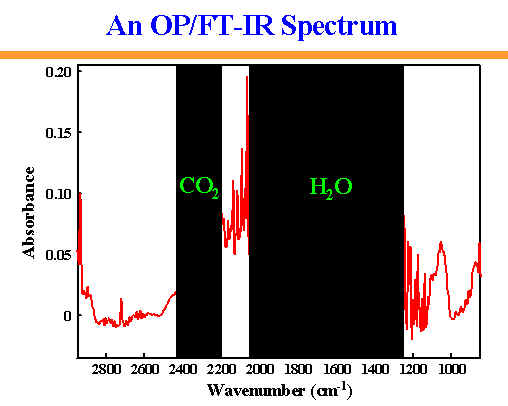
|







